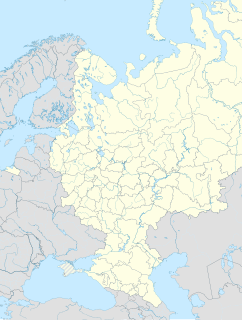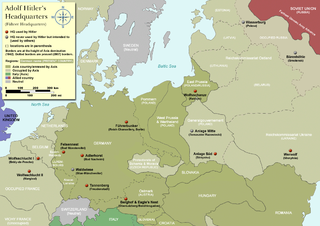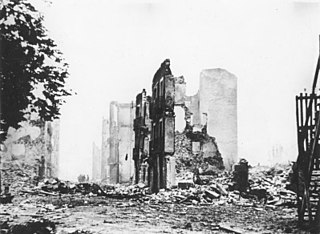 W
WThe Arkhangelsk–Astrakhan line, or A–A line for short, was the military goal of Operation Barbarossa. It is also known as the Volga–Arkhangelsk line, as well as the Volga–Arkhangelsk–Astrakhan line. It was first mentioned on 18 December 1940 in Führer Directive 21 which enunciated the set goals and conditions of the German invasion of the Soviet Union, describing the attainment of the "general line Volga–Archangelsk" as its overall military objective.
 W
WThe Blomberg–Fritsch affair, also known as the Blomberg–Fritsch crisis, was the name given to two related scandals in early 1938 that resulted in the subjugation of the German Armed Forces (Wehrmacht) to dictator Adolf Hitler. As documented in the Hossbach Memorandum, Hitler had been dissatisfied with the two high-ranking military officials concerned, Werner von Blomberg and Werner von Fritsch, and he regarded them as too hesitant towards the war preparations that he was demanding. Hitler took further advantage of the situation by replacing several generals and ministers with men more loyal to him.
 W
WThe Führer Headquarters, abbreviated FHQ, were a number of official headquarters used by the Nazi leader Adolf Hitler and various other German commanders and officials throughout Europe during the Second World War. The last one used, the Führerbunker in Berlin, where Hitler committed suicide on 30 April 1945, is the most widely known headquarters. Other notable headquarters are the Wolfsschanze in East Prussia, where Claus von Stauffenberg in league with other conspirators attempted to assassinate Hitler on 20 July 1944, and Hitler's private home, the Berghof, at Obersalzberg near Berchtesgaden, where he frequently met with prominent foreign and domestic officials.
 W
WNazi Germany operated around 1,000 prisoner-of-war camps during World War II (1939-1945).
 W
WGerman rearmament was a policy and practice of rearmament carried out in Germany during the interwar period (1918–1939), in violation of the Treaty of Versailles. It began on a small, secret, and informal basis shortly after the treaty was signed, but it was openly and massively expanded after the Nazi Party came to power in 1933.
 W
WThe goose step is a special marching step performed on formal military parades and other ceremonies. While marching in parade formation, troops swing their legs in unison off the ground while keeping each leg rigidly straight.
 W
WThe Ministry of Aviation was a government department during the period of Nazi Germany (1933–45). It is also the original name of the Detlev-Rohwedder-Haus building on the Wilhelmstrasse in central Berlin, Germany, which today houses the German Finance Ministry.
 W
WOperation Valkyrie was a German World War II emergency continuity of government operations plan issued to the Territorial Reserve Army of Germany to execute and implement in case of a general breakdown in civil order of the nation. Failure of the government to maintain control of civil affairs might have been caused by the Allied bombing of German cities, or uprising of the millions of foreign forced labourers working in German factories.
 W
WThe term Reichskriegsflagge refers to several war flags and war ensigns used by the German armed forces in history. A total of eight different designs were used in 1848–49 and between 1867–1871 and 1945.
 W
WThe Reichskriegsgericht was the highest military court in Nazi Germany.
 W
WThe Reichsmarine was the name of the German Navy during the Weimar Republic and first two years of Nazi Germany. It was the naval branch of the Reichswehr, existing from 1919 to 1935. In 1935, it became known as the Kriegsmarine, a branch of the Wehrmacht; a change implemented by Adolf Hitler. Many of the administrative and organizational tenets of the Reichsmarine were then carried over into the organization of the Kriegsmarine.
 W
WReichsmarschall of the Greater German Reich was the highest military rank in the Wehrmacht of Nazi Germany during World War II.
 W
WThe remilitarization of the Rhineland began on 7 March 1936, when German military forces entered the Rhineland, which directly contravened the Treaty of Versailles and the Locarno Treaties. Neither France nor Britain was prepared for a military response, so they did not act. After 1939 commentators often said that a strong military move in 1936 might have ruined Hitler's expansionist plans. However, recent historiography agrees that both public and elite opinion in Britain and France strongly opposed a military intervention, and neither had an army prepared to move in.
 W
WGerman involvement in the Spanish Civil War commenced with the outbreak of war in July 1936, with Adolf Hitler immediately sending in powerful air and armored units to assist General Francisco Franco and his Nationalist forces. The Soviet Union sent in smaller forces to assist the Republican government, while Britain and France and two dozen other countries set up an embargo on any munitions or soldiers into Spain. Nazi Germany also signed the embargo but simply ignored it.
 W
WThe Wehrmacht was the unified armed forces of Nazi Germany from 1935 to 1945. It consisted of the Heer (army), the Kriegsmarine (navy) and the Luftwaffe. The designation "Wehrmacht" replaced the previously-used term Reichswehr, and was the manifestation of the Nazi regime's efforts to rearm Germany to a greater extent than the Treaty of Versailles permitted.
 W
WThe Heer as the German army and part of the Wehrmacht inherited its uniforms and rank structure from the Reichsheer of the Weimar Republic (1921–1935). There were few alterations and adjustments made as the army grew from a limited peacetime defense force of 100,000 men to a war-fighting force of several million men.